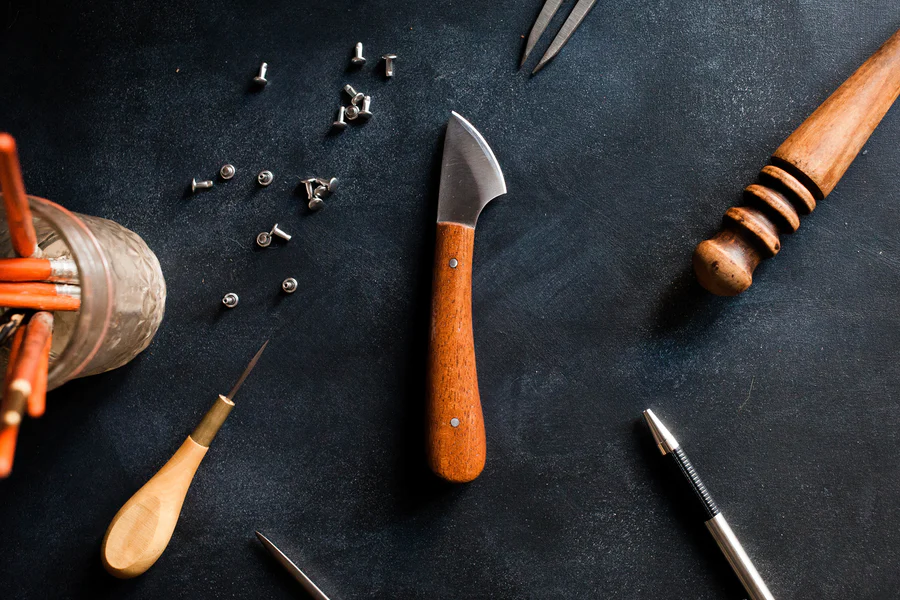Leatherworking tools are indispensable both for beginners in homemade accessories and for more large-scale production related to leather products.
Some of the tools on sale can be completely replaced with analogues that are found in literally every kitchen, but this option is acceptable only at the stage of amateur furriery. The production of high-quality high-quality leather goods requires a professional set of tools – the quality of processing with them goes to a whole new level.
Leather Tools
Depending on the purpose, tools for the skin are divided into the following types:
- Leather sewing tool
- Marking tool
- Edge finishing tool
- Leather knives and scissors
- Other tools
Let’s talk in more detail about each of these types of leather processing tools.
Leather sewing tools
Leather sewing tools include the following accessories:
- Cross awl, so called because in cross section it forms a rhombus. Used for stitching and braiding leather.
- Round (Turkic, dagger awl). It is used for sewing and braiding when it is necessary to thread more cord into the hole into which the thread has already been threaded. The small round awl is used for seams and the large one for making belts.
- Adjustable punching pliers – with their help make holes for the braid.
- Needles for inserting thread with a blunt end (furrier needles).
- Saddlery needles with a triangular section, which cut a hole with their sharp edges, and therefore enter the skin more easily than ordinary ones.
- Needle with a blunt end. It will come in handy if you sew pieces of leather along holes pierced in advance with an awl – then it is less likely to go astray from the intended points and inadvertently pierce new ones.
- A bone or a special wooden tool for smoothing braids, emphasizing reliefs and basting.
- Cricut machine will be quite useful if you want to cut sewing patterns and hundreds of different material types.
Marking tool
This kind of leather processing tools includes a roller and a marking compass. A roller (or wheeled basma) is used to accurately mark the distance between stitches. This is done as follows: before stitching, the roller is advanced along the place where the seam should be.
A marking compass is used to mark the distance from the edge of seams or braids. It is also used when basting the width of the belt in the process of cutting it out. When working with this tool, one end of the compass is pressed against the edge of the skin, the distance is set by adjusting the legs, and with the width set, the other end of the compass, putting it on the skin, makes a basting.
Edge tool
Designed for cutting from the edges of a thin strip, triangular in cross section. Thanks to the edge finishing tool, the edges, free from seams and braids, will look clean and finished.
In the event that a leather product is cut from loose and not strong enough leather, its edge will be ugly and disheveled, and this is when an edge finishing tool will come in handy. It is used as follows: the skin is placed face down on the table, and along the wrong side, along the edge of the skin, the tool is advanced by pressing on its cutting blade.
Useful advice: If an edge finishing tool is not available, you can simply singe the remaining free edges of the skin above the candle, and this will help to complete the product. At the same time, try to singe, first of all, the inner edge, and first check the resistance of the skin to fire on a small piece of material.
Leather knives and scissors
The tool for cutting leather includes a huge variety of knives, as well as scissors, the choice of which is determined by the type of product being made, the quality of the leather and many other aspects. Knives for working with leather are divided into knives with one-sided sharpening and scouring knives.
Traditional leather knives with one-sided sharpening are both straight and curved. Knives with a curved blade are well suited for cutting out wavy lines in cases where scissors cannot be used (say, leather is more than 2-3 mm thick).
A straight knife is used for cutting belts, straight lines and trimming threads. There are also prefabricated knives, including interchangeable straight, oblique and curved metal blades or scalpels. Shoemakers use a handless knife in their work – due to the shape of its point, it copes well with cutting thick, stable leather soles.
Scouring knives come in the shape of a crescent or a quarter of a month. Scouring is a thinning of the edge of the skin, which is necessary for gluing blanks of leather goods, shoes and overlapping bindings.
Leather scissors are divided into straight (tailor’s) and zigzag scissors. If you have just started working with leather, and are processing material with a thickness of 2-3 mm, it is better to prefer scissors than a knife, because they are not only more convenient, but also safer to work with.
You may also like
-
Common Misconceptions About Disability Law and Lawyers
-
Finding the Right Disability Lawyer: Key Factors to Consider
-
Creating Families Across Canada: The Journey Through Adoption
-
Understanding the Practical Applications of Ibutamoren in Research
-
Navigating Regulations and Permits in the Crude Oil Hauling Industry
